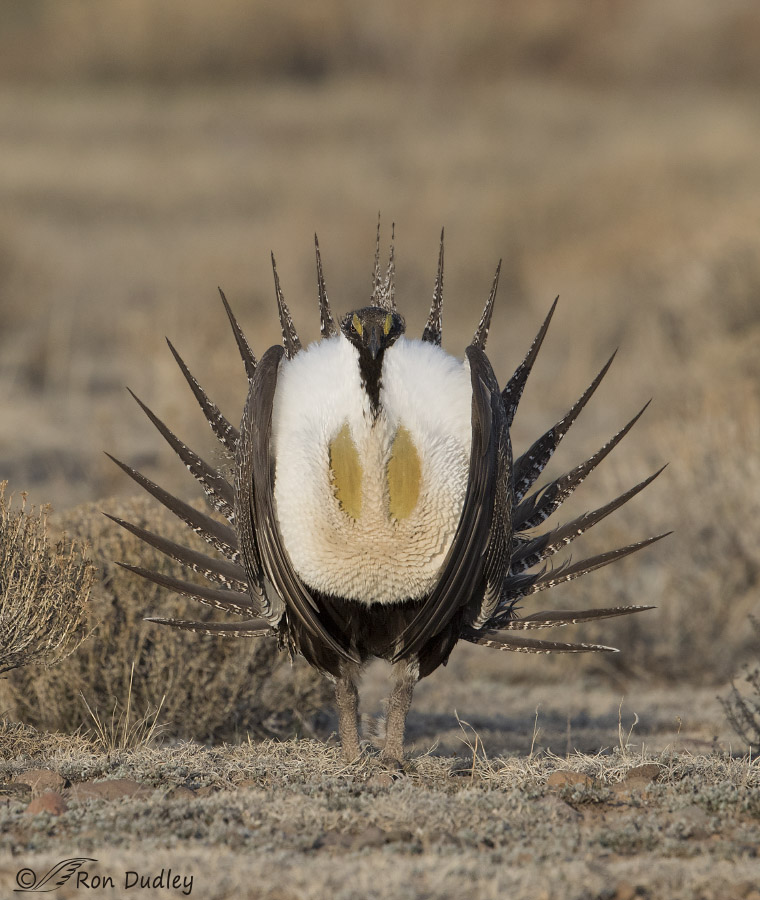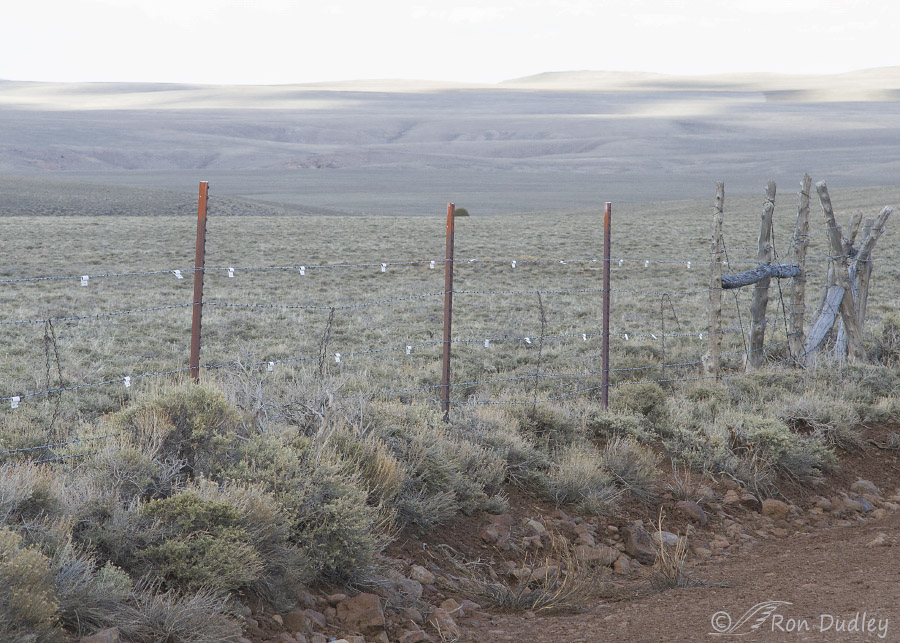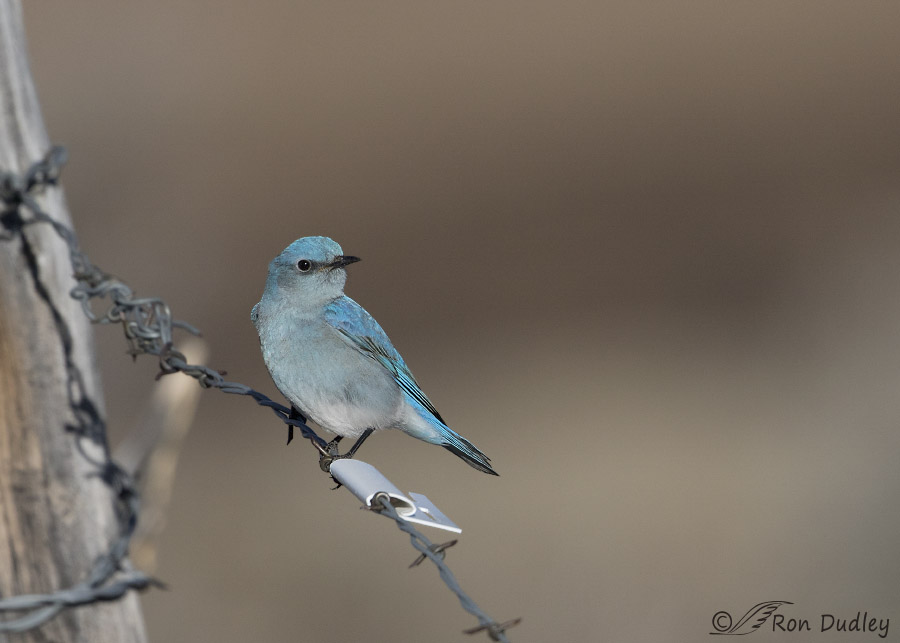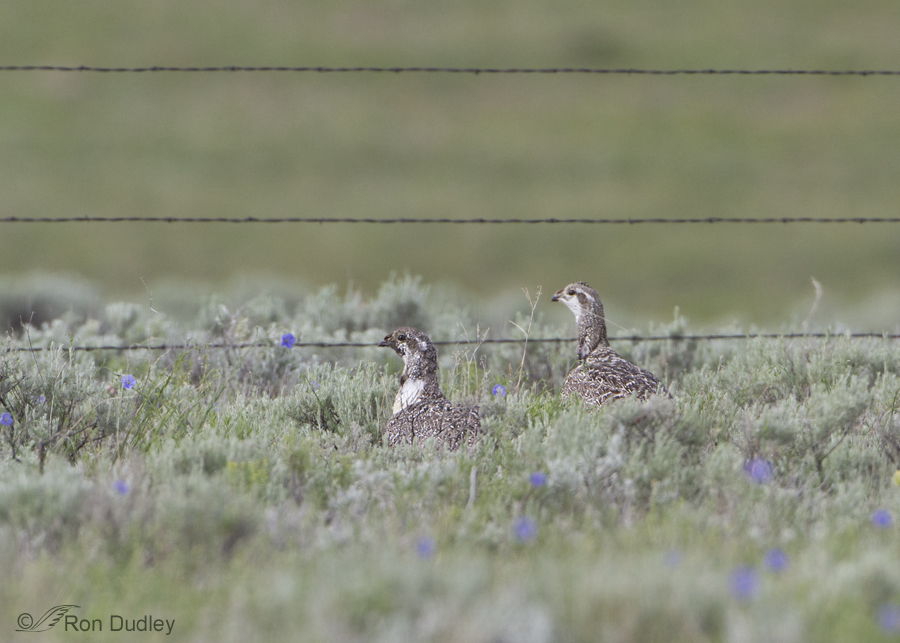When Sage-Grouse collide with fences the results are often catastrophic for the birds. And it happens all to often.

1/800, f/9, ISO 800, Canon 7D Mark II, Canon EF500mm f/4L IS II USM +1.4 tc, not baited, set up or called in
Greater Sage Grouse flight behavior was shaped by the vast open plains of their habitat when there were no vertical obstacles protruding above the sagebrush which allowed them to habitually and safely fly just above the low shrub canopy without having to negotiate obstacles. But when man introduced the now ubiquitous and difficult to see barbed wire fence all that changed to the detriment of the bird. Imagine what happens when a heavy (up to 8+ lbs), fast-flying (as fast as 50 mph) bird doesn’t see a wire and collides with it. Even when wires are seen at the last moment this largest grouse in North America isn’t very maneuverable (their flight patterns have been compared to those of B-52 bombers) and collisions are often unavoidable.
To give you an idea of how lethal these fence/grouse interactions can be, in one study a two-mile length of Utah fence killed 36 Sage Grouse the first winter it was installed and a similar fence in Wyoming killed 21 birds. Fence lethality increases exponentially when fences are found near leks where grouse gather in large numbers in early spring to perform their breeding rituals.
A method that has proved effective in reducing grouse fence mortality is the placement of fence tags or markers on the wires to make them more easily seen by the grouse.

I photographed this fence a few days ago within a few hundred yards of an active Sage-Grouse lek in a remote area of Wayne County, Utah. The fence has been fitted with white plastic tags to allow grouse to see the wire more easily. Some fences are “double-tagged” with both white and black tags since the black tags are better seen when there’s snow on the ground, which there often is when the birds are on the lek. Notice how difficult it is to see the relatively new shiny wire (without the tags) against typical grouse habitat in the background.
These tags or markers have proven effective in preventing lethal collisions between wire and upland game birds of several species. For example, Sutton Avian Research Center has marked over 100 miles of fence where there were frequent Lesser Prairie-Chicken collisions and deaths historically and haven’t documented a single collision or death since the fences were tagged.

Though several different kinds of markers are used here’s a closer look at one type I found in Wayne County (I cajoled this dandy male Mountain Bluebird to pose next to it for a little aesthetic enhancement… ). This photo was taken at the very edge of the second lek we found on this trip.

Here’s a visual representation of how vulnerable Sage-Grouse are to barbed wire (image taken two summers ago in southwest Montana). Even though this rusty wire looks relatively easy to see against the green background the birds still often collide with them, especially because they fly into the lek before dawn when it’s still dark.
When I first began to notice tagged fences a few years ago, in my ignorance I didn’t appreciate them much for two reasons: the “visual pollution” they cause in remote landscapes and I was skeptical about their effectiveness in preventing collisions.
Since that time continuing research has shown that they are effective in significantly reducing grouse mortality and to me the aesthetic issues that may or may not be caused (depending on your perspective) by the markers are a small price to pay in the efforts to save a highly endangered species.
Ron
Note: For those who may be interested here’s a couple of links that provide more information about the fence-tagging efforts and their effectiveness.


I know too well what the damned stuff can do to pronghorns and horses…especially what it did to one beautiful, sweet Morgan horse.
I am, unsurprsingly, with Patty about 100000 per cent (conservatively speaking). I would happily attend that roll-up.
And yes, the accusative gaze of that grouse is stunning, visually appealing, and more than appropriate.
I figured you might be with Patty on that one, EC. Barbed wire is the bane of the west in so many ways…
Yes I also hate barbed wire, fences and everything that prevents wild life to do what they have done for ages.
And I am happy to see that something has been done to avoid those deaths.
But I want to point out something else. The awesome photo of that Sage Grouse you posted today. Just beautiful and the perfect image to start your post. Standing there in all it’s beauty looking straight into our eyes and accusing us.
Very well done Ron.
I’m so happy that you liked that image so much, Jorge. So do I, the symmetry of it really appeals to me. Thanks very much.
Sometimes (often) I wish every outspoken advocate of barbed wire would be stripped naked, wound up in the damned stuff and slowly rolled down a very long, steep hill…then we’ll talk–maybe….
I’m beginning to suspect that you really DON’T like barbed wire, Patty!
Oh my Patty lol…I couldn’t have said it better.
Love the Bluebird Ron!
Good morning, Ron– You must know how I feel about “Devil Wire” by now, so I find tagged/flagged wire almost beautiful…even better would be all of the damned stuff gathered up and melted down into something useful and oharmless.
Ron, I’m so glad to see measures like this being taken … along with actual replacement of barbed wire in some places. What a vicious deterrent these fences are for so many species. Up here in Snow Goose and swan zones, utility wires are similarly fitted with tags, which I realize are now a more common sight in other areas, too. I may have a false sense of hope when I see them — thinking, well, at least in this place, people do care. Whenever I see long stretches of barbed wire and lines, though, I can’t help but think of the first generation of peoples and wildlife who had to contend with the rampaging force of western expansion and entitlement. The primary-source accounts I’ve read are obviously nothing short of devastating.
We have tags on some of our utility wires too, Ingrid – especially in bird-dense areas. Utility companies have become increasingly sensitive to bird issues, including making our power poles safer for birds from electrocution and that’s a good thing. I just wish some oft these efforts had begun many, many years ago.
Here’s to finding the joy in those white tags. They are ugly but I can find a lot of beauty in saving this beautiful bird.
It took me a while to find that joy, Arwen but I have it now…